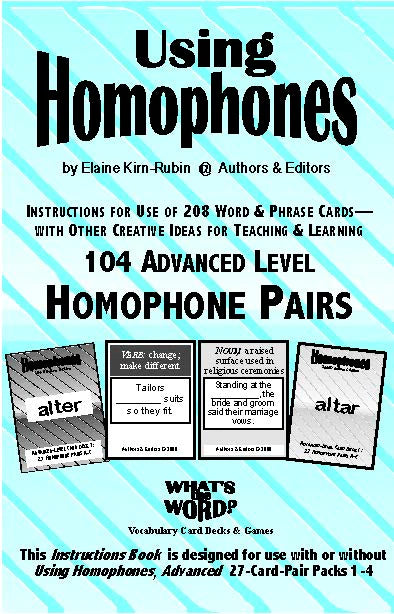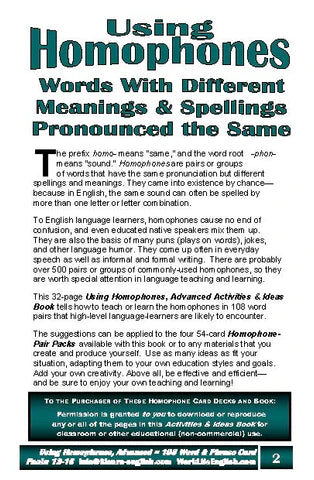2LEARN-ENGLISH
C-05c Using Homophones 44 Page Advanced Activities & Ideas Book + 27 Pair Card Decks 12-15 (Print Version + Shipping)
C-05c Using Homophones 44 Page Advanced Activities & Ideas Book + 27 Pair Card Decks 12-15 (Print Version + Shipping)
Description:
These decks consist of 108 pairs of matching homophones, which are words that have different spellings but the same pronunciation. Designed for advanced language students, these decks feature polysyllabic words with unusual vowel or consonant spellings, grammatical endings, silent letters, compounds, and other intriguing linguistic oddities commonly found in educated speech and writing. The decks come complete with Sound & Spelling Charts, pedagogical Notes, Word Lists, Quizzes with Answers, and creative ideas for learner-created materials.
Key Components:
- Four Decks (12-15) of Advanced Homophone Cards (108 pairs)
- 32-page Activities & Ideas Book
Pages:
248 pages
Who They're For:
- Students aged 5 to 8
- Secondary students
- Young adults
- Adults
- Independent learners
- Home school students
- English improvement programs
- ESL and EFL learners
- Literacy programs
- WIOA (Workforce Innovation and Opportunity Act) participants
- Career and college preparation programs
- Corrections institutions
What They Are:
Advanced Homophone Decks 12-15 contain 108 pairs of matching homophones (different words pronounced but not spelled the same) that are useful in educated speech and writing. These include polysyllabic words with unusual vowel or consonant spellings, words with grammatical endings, items with silent letters, compounds, and other "oddities" that come up naturally. Examples are assent/ascent, aural/oral, boy/buoy, carat/carrot, marshall/marshal, overdue/overdo, and the like. There are Sound & Spelling Charts, pedagogical Notes, Word Lists, Quizzes with Answers, ideas for learner-created materials, and the like.
Why You Need Them:
Advanced language students, including independent learners and educated native speakers, may want exposure to "all there is to know" about vocabulary they can use in their everyday lives and work. Though no "educational product" provides practice in all homophonic pairs and groups that exist or may be created in English, the 216 items of these five two-sided card packs--with corresponding documentation--contain plenty of representative examples. Proficient learners might enjoy manipulating and working/playing with--and going beyond--such "sophisticated" materials.
What They Do:
serve as flash cards for the recognition and production of 216 "upper-level" vocabulary words, all of which are homophones of one or two other items. Card users can view contextualized examples with blanks and definitions of the items on card backs; later these become cues for recall of the items as well as triggers for their use in context.
review procedures for learning activities and games particularly suited to the targeted material--and other vocabulary that follow the same principles
- offer explanation, instructions, and supplementary ideas in a 32-page Activities & Ideas Book, which
- tells why homophones exist in English, giving charts of the spellings that produce them
- explains how the cards work, suggesting other ways to use them efficiently and effectively.
- gives other ways to teach and/or learn these interesting vocabulary pairs
- offers reproducible Mastery Checks of two kinds, paraphrasing exercises and a story with multiple misspellings to correct--with Answer Keys, of course
- includes Reference Lists of all relevant items for all three levels of materials
Digital Version Available:
To buy Digital Version click here!
Couldn't load pickup availability








